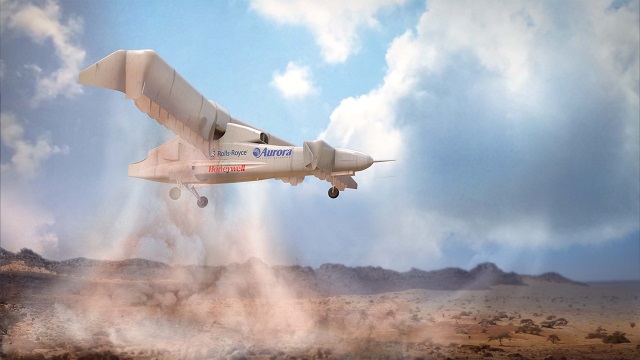Aurora Flight Sciences sees its victory over Boeing, Sikorsky and Karem Aircraft for the US Defense Advanced Research Project Agency’s $89 million “VTOL X-Plane” flight test programme as a strategic win that positions it well to someday compete in the Army’s Future Vertical Lift programme.
The company proposed LightningStrike: a hybrid-electric air vehicle powered by 24 ducted fans on its tilting wing and canard. The company hopes this odd-looking design will be designated the X-57 as the next American X-plane in the series that started in 1946 with the Bell X-1.
With electric power generated by a single Roll-Royce AE1107C engine coupled with Honeywell generators, a full-scale LightningStrike aircraft is expected to fly in mid-2018 and reach speeds of 300-400kts.

Aurora’s LightningStrike programme manager Carl Schaefer and chief engineer Graham Drozeski tell Flightglobal that the aircraft is meant to be a technology demonstrator and is not in a militarised, operational configuration. However, the electric ducted fans, drive system, flight control laws and other technical features will show up in future fixed-wing and vertical-lift platforms proposed by Aurora, they say.
The company is “absolutely” eyeing the army-led Future Vertical Lift (FVL) acquisition that seeks to introduce a family of long-range, high-speed and manoeuvrable aircraft types, possibly starting with a successor to the Sikorsky UH-60 Black Hawk and Boeing AH-64 Apache in the 2030s. Aurora sees itself going after any mid-size FVL aircraft requirement, described by the army as Capability Sets 2 and 3.
“We’ve been talking to the FVL programme office and others about the technology,” says Schaefer. “I don’t think the way the aircraft is configured is something they’d be interested in [but] we have looked at manned versions of this and we have conceptual designs for those.”
USA rotorcraft companies vying for FVL include Lockheed Martin-owned Sikorsky, Boeing, Bell Helicopter, Karem, AVX and Piasecki. Aurora has not yet decided if the business case exists or if it will team or compete as a prime contractor, but it is monitoring FVL closely.
A military hybrid electric aircraft would likely have two power-generating motors and a triple-redundant power distribution system, but it is the concept’s agility and efficient transition from hover to forward flight that could set it apart.
“The purpose of this LightningStrike airplane is not to deliver troops into battle or prosecute targets. It’s to prove new technologies, and if it’s successful at doing this, which we think it will be, hopefully it will spawn entire new lines of aircraft,” says Drozeski.
The company first proved its LightningStrike configuration using a ground test rig known as the Copper Bird and a 20% subscale version first flew at a military test facility on 29 March, shortly after selection.

That miniature version employs very similar avionics systems and flight control laws as the full-scale X-plane and it will soon demonstrate the transition from hover to forward and reverse flight. It will eventually “fly above 100kts”. A government preliminary design review was completed as part of Phase 1, and now the company is setting up a hardware-in-the-loop “Iron Bird” test assembly to conduct a complete end-to-end trial of the power generation and distribution system at Rolls-Royce LibertyWorks in Indianapolis.
The aircraft is being fabricated at Aurora’s facilities in Mississippi and West Virginia and final assembly and checkout flights will take place in Manassas, Virginia.
Schaefer has an explanation for how Aurora settled on the LightningStrike vehicle and bested its “incredible competitors” for the construction and flight test phase.
“We wanted to go for something that had splash but we felt we could pull off,” he says, noting that the company also considered a fan-in-wing type similar to Boeing’s Phantom Swift. “It didn’t have to just look sexy, it really had to work. We did look at tail-sitters and some other things as well.
“It wasn’t just the unique air vehicle configuration that got us across the line. It think it had everything to do with successfully executive Phase 1. We didn’t just do really good engineering, but we did a significant number of risk-reduction tests that convinced DARPA this was doable.”
Pictures courtesy of Aurora.
Source: FlightGlobal.com




























